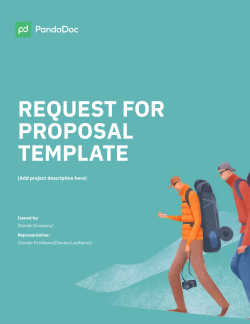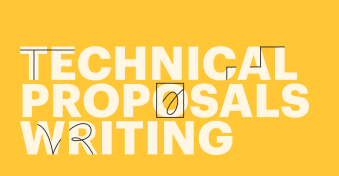So, you’ve just received a Request for Proposal (RFP), and now you’re probably wondering, “How in the world do I tackle this?”
Receiving an RFP can be an exciting chance to showcase your skills and charm the socks off potential partners.
However, for many sales professionals, RFPs are complicated, overwhelming, and downright terrifying. But responding to an RFP successfully doesn’t have to feel like deciphering ancient scrolls.
In this article, we will break down the art of creating a winning response to an RFP in the friendliest way possible.
No jargon, no confusing acronyms—just 14 practical tips to help you shine the next time an RFP lands in your inbox.
→DOWNLOAD NOW: FREE REQUEST FOR PROPOSAL RESPONSE TEMPLATE
Key takeaways
- Instead of being pushy and generic, focus on the client’s needs and provide solutions that align with their goals and needs.
- Pay close attention to the details that can be found in an RFP, including the smallest ones. Address them all, showing your ability to meet every project specification.
- Respond to RFPs as quickly as possible to be ahead of competitors and to give decision-makers enough time to evaluate your bid. If the RFP isn’t a good fit, politely reply to avoid being overlooked for future opportunities the client might provide.
- Present a clear roadmap in your proposal, detailing all the important milestones. This will show you have a solid understanding of managing the project.
RFP response process explained: what is a response to an RFP?
Before we get to the tips, it’s essential to understand what an RFP is designed to do.
In short, an RFP response is like a business proposal done in reverse.
Instead of soliciting companies with your goods and services or trying to identify a problem and create a solution, organizations producing an RFP already know they have a problem.
And they are asking for your help to fix it.
Most RFPs give you everything you need to include in your RFP response. Typically, this will consist of most of the following:
- An executive summary describing the opportunity
- A scope of work and expected deliverables
- Contact information for project stakeholders
- Details about the selection process
- Detailed information about a client’s needs and objectives
- Information on how to respond to an RFP
In other words, the RFP is your cheat sheet for how you should write your business proposal.
The hard (and terrifying) part is writing a document to generate a winning RFP response.
With that in mind, here’s a brief guide on how to create a winning RFP response.
Step-by-step guide for how to respond to an RFP
- Review the RFP: Carefully read the entire RFP to understand the client’s requirements and expectations.
- Understand the scope: Clearly define the project’s scope and identify key deliverables.
- Organize a response team: Put together a dedicated team with expertise in relevant areas to contribute to the response.
- Create a response outline: Develop a structured outline that aligns with the RFP sections, addressing each requirement clearly.
- Tailor your proposal: Customize your response to highlight your unique qualifications, experience, and how your solution meets the client’s needs.
- Provide clear pricing: Present transparent and detailed pricing information, ensuring it aligns with the proposed scope of work.
- Showcase relevant experience: Highlight past successes and case studies demonstrating your organization’s capability in similar projects.
- Include a timeline: Outline a realistic project timeline, showcasing key milestones and deadlines.
- Quality control: Ensure the response is error-free, cohesive, and professionally presented.
- Submit on time: Adhere to the deadline and follow the client’s specified submission process, including any required formats or documentation.
RFP responses best practices: top tips for responding successfully
Let’s look at some of these steps in more detail and learn the best tips for putting a winning RFP response together.
1. Be direct and specific
When responding to RFPs, always speak to the specific problems in the document.
Pay careful attention to small details, and demonstrate your competence by offering solutions that directly address those pain points.
Most RFPs are designed as part of a competitive process. You aren’t the only one who received the request and are unlikely to be the only respondent.
Put your best foot forward, confirm that all specifications can be met, and increase your chances of winning by offering examples that resonate with issuers and project stakeholders.
Generic: Our team is committed to providing support and training for software onboarding.
Specific: Our team understands that new software can be difficult to work with. As part of your installation and ongoing service, we provide eight (8) one-hour onboarding sessions to help you get up and running and 24/7/365 live technical support.
Remember, speak to your client’s needs
Your RFP proposal response should be informative, valuable, and transparent to succeed.
Don’t include a pushy call to action or boast too much. Instead, add detailed descriptions of your understanding of the client’s goals and your methods to achieve them.
Focus more on the client’s needs than on your own experience.
Remember, all the information you need is already in the received RFP documentation.
Rather than providing generic phrasing, aim for wording that speaks to the goals and objectives the client is trying to accomplish.
Generic: Our company has been recognized as an industry leader capable of solving challenges for companies like yours.
Needs-focused: Our company has been recognized by [XZY Organization] as an industry leader in helping brands accomplish [Client Need 1], [Client Need 2], and [Client Need 3].
2. Always respond promptly
If you receive an RFP request from a potential client, do your best to respond quickly and efficiently.
This is especially true if you’re in a niche industry or a smaller market.
Responding quickly gives decision-makers enough time to evaluate your bid and start the negotiation and evaluation process.
Small businesses may have limited time to evaluate bids or engage with the RFP response process.
If the proposal team is working on a tight deadline or time frame, waiting until the last minute to submit may mean they don’t have time to consider your proposal fully.
3. Make sure your timeline is detailed
Add a clear timeline to your proposal, one where you reflect all the important milestones.
This detailed timeline gives the client a clear idea of when they can expect each project stage to be completed and shows that you have a structured approach to managing the project.
A proposal with a timeline shows that you have a well-thought-out plan for the project and can help set realistic expectations for the client.
It also demonstrates your ability to manage projects effectively and meet deadlines.
Example: Suppose you’re responding to an RFP for a digital marketing campaign. Your timeline might look something like this.
Week 1: Kick-off meeting to understand your specific needs and goals.
Week 2—3: Market research and strategy development.
Week 4: Presentation of the marketing strategy for your approval.
Week 5—8: Content creation and campaign setup.
Week 9: Launch of the marketing campaign.
Week 10—20: Monitoring and adjusting the campaign as necessary.
Week 21: Final report and review meeting.
4. Give yourself room to negotiate
RFPs and similar competitive processes may give the impression that the lowest price always wins, but race-to-the-bottom pricing isn’t the way to go.
When you or your sales team submit a proposal, be sure that you give yourself enough room to negotiate your price based on any unforeseen obstacles or additional requirements.
If you aim for the lowest price possible or constantly change your pricing to win a bid, it’s easy to end up working for less than your time is worth.
Worse, you could even lose money on a project when you account for procurement and labor costs!
Set your price, stick to it, and give yourself room to negotiate.
Know your limits and how low you can safely go before the payout no longer makes sense for your business.
Example: Suppose you’re a software development company responding to an RFP for a new mobile app. You’ve estimated that the project will cost around $50,000 based on the requirements outlined in the RFP. However, you know from experience that there can be unforeseen challenges or changes in scope during the development process.
Instead of submitting a proposal with a fixed price of $50,000, you decide to quote a price of $55,000.
This allows you to negotiate if the client feels the price is too high without compromising the project’s profitability.
In your proposal, you could write something like this:
Our estimated cost for this project is $55,000. This includes all development work, project management, testing, and post-launch support. We understand that cost is a significant factor in your decision, and we are open to discussing this estimate further. Our primary goal is to deliver a high-quality app that meets your needs and provides value to your users.
5. Automate your RFP response
If you have past projects, case studies, or other powerful examples that align with the metrics and milestones that the document describes, include them in your RFP response.
Providing references from past clients can significantly strengthen your proposal.
It reassures potential clients about the quality of your work, your reliability as a service provider, and your ability to deliver on your promises.
References can serve as powerful testimonials that validate your claims and demonstrate your track record of success.
First, identify past clients who can vouch for your work.
Ideally, these should be clients for whom you’ve completed projects similar to your proposal.
Then, ask your past clients permission if they are comfortable being used as references.
Explain why you’re asking and who might be contacting them. This is courteous and gives them time to prepare thoughtful responses.
Include their name, title, company, and contact information when listing references in your proposal.
Also, briefly describe the project you completed for them and how it relates to the current proposal.
Finally, If you know a potential client will contact your references, give those references a heads-up.
Remind them of the relevant details of the work you did for them and thank them for their time.
Example: In your proposal, you could include a section like this:
We understand the importance of trust in choosing a service provider. Here are a few references from past clients who can speak to the quality of our work and our commitment to client satisfaction:
Jane Smith, CEO of Company A: We worked with Company A to develop a new mobile app.
Jane can speak to our technical expertise, creative problem-solving abilities, and dedication to meeting deadlines. Contact: jane.smith@companya.com
John Doe, Marketing Director of Company B: We managed a six-month digital marketing campaign for Company B. John can provide insight regarding the results we achieved and our approach to communication and reporting. Contact: john.doe@companyb.com
6. Proofread your proposal for typos
The proposal process can get a little chaotic for everyone involved.
Before you submit your RFP response, take a little time to review your documents for typographical and formatting errors before you submit.
If you don’t have access to an editor, the best way to do this is to have someone not involved with the document creation process provide feedback for the language you’ve used in documents.
You can use AI tools for proofreading purposes, as well.
This approach is especially efficient for checking long-form documents when you don’t have enough time for manual proofreading.
Keep in mind that some documents in your proposal are more valuable than others, and a single typo in your document (usually) won’t equate to some kind of instant disqualification.
However, a vast difference exists between a typo on a line item and misspelling a potential client’s name in the cover letter or executive summary.
Example: Start by reading through the proposal yourself. Look for any obvious typos, grammatical errors, or awkward sentences.
Check that the proposal is clear, concise, and easy to understand.
Next, ask a colleague who didn’t write the proposal to review it.
They’ll bring a fresh perspective and may spot errors or ambiguities that you missed.
Consider using a tool like Grammarly or Microsoft Word’s spell check to catch any spelling or grammar mistakes.
These tools can be a helpful backup but shouldn’t replace a manual review.
Remember that the initial requester may not be the direct point of contact for the proposal itself.
Often, the RFP request is generated by an admin or a staff member who isn’t involved with the final decision-making process.
When responding, verify the direct contact information of the individual seeking your response.
This will be included in the RFP.
→DOWNLOAD NOW: FREE REQUEST FOR PROPOSAL RESPONSE TEMPLATE
7. Keep your proposal short and sweet
Your potential customer isn’t looking for a sales pitch when they write an RFP.
They’re seeking someone to help them complete a specific project or objective.
You can help them fully consider your proposal by keeping things short and to the point.
Tell them what you plan to do, how you plan to do it, and why you’re a better fit than your competitors. Make sure that the information you provide aligns with their needs.
Nothing else (other than a polite thank you for their consideration) is required.
Generic: Our company, with its highly skilled professionals and state-of-the-art technology, is fully equipped to handle all your web development needs. We have a proven track record of delivering high-quality websites that meet our clients’ business objectives and exceed their expectations.
Short & sweet: Our team can build a user-friendly, SEO-optimized website for your business that drives traffic and conversions. We’ve done this successfully for clients like Client A and Client B.
8. Send the proposal to the right point of contact
Remember that the initial requester may not be the direct point of contact for the proposal itself.
Often, the RFP request is generated by an admin or a staff member who isn’t involved with the final decision-making process.
When responding, verify the direct contact information of the individual seeking your response.
This will be included in the RFP.
Example: If the RFP states that proposals should be sent to John Doe, the Director of Marketing, but you’ve been communicating with Jane Smith, a Marketing Associate, you should send your proposal to John Doe (as instructed in the RFP) but also CC Jane Smith since she’s been your point of contact.
9. Consult SMEs early
Consulting subject matter experts can be critical to creating an accurate proposal for complex proposals.
Bring them on early in the process, give them time to respond, and provide feedback on moving forward.
As you bring on additional team members to tackle a proposal, have them assist with research and requests that can help the SME contribute to the project’s scope.
In doing so, you can provide the client with a better understanding of the steps you intend to take if your proposal is accepted.
Example: If responding to an RFP for a cybersecurity solution, you should involve your cybersecurity experts from the beginning. They can help identify potential challenges, suggest effective solutions, and provide accurate estimates for the project. This can result in a more compelling and realistic proposal.
10. Use analytics to learn what works and what doesn’t
Every proposal you send is a learning opportunity for your business and team.
While some companies may only accept proposals in a PDF format, others may be open to receiving them via a direct link.
In that case, take full advantage of the opportunity to gather data on the performance of your proposal.
PandaDoc and other RFP software tools allow documents to be tracked so that you can gain important insights into how clients reviewed your document.
With PandaDoc, you can see when your document was received, who viewed it, and how much time was spent on each page.
Why does this matter?
By learning how your document is handled, you can continue to streamline your proposal success by improving pages that are routinely ignored and figuring out your next best step.
Problems with your RFP and sales workflows can tank close rates.
Figuring out what works is key to reducing confusion and moving deals forward.
Example: You’re using a tool like PandaDoc to send your proposals. You notice that clients spend a lot of time on the pages that contain case studies, but they quickly skim over the pages that describe your company’s history.
Based on this information, you might move the case studies to an earlier section in your future proposals and reduce the information about your company’s history.
11. Emphasize your value
Responding to an RFP is already a competitive exercise.
You can’t always stand out above the pack based on pricing alone because you can’t cut your prices to the point where you get nothing in return.
But the one thing you can do is emphasize the value of choosing your proposal over that of your competitors. These differentiators are often the key to winning in a competitive process.
Take a minute to consider: What makes your offer different?
Do you have an outstanding track record that you can leverage to demonstrate your reliability? How about a team with unique expertise?
Or maybe a new framework or approach to solving the problem that delivers incredible results?
Ask yourself these questions at the start of the proposal process, and then create a draft that reflects those values.
Example: You’re a software development company responding to an RFP for a new mobile app.
Instead of just stating that you can build the app, you could emphasize your value by writing something like:
We can do more than develop a high-performing mobile app for you — we also offer post-launch support and app marketing services to ensure the success of your app. In our previous project for Client A, these additional services resulted in a 50% increase in app downloads in the first three months post-launch.
This statement emphasizes your additional value and gives a concrete example of how this value has benefited a previous client.
12. Follow up after submitting your proposal
Following up after submitting your proposal shows the potential client that you are proactive, interested in their project, and ready to answer any questions they may have.
It also gives you a chance to reiterate key points from your proposal.
Example: A few days after submitting your proposal, you could send an email like this:
Dear [Client’s Name],
I just wanted to follow up on the proposal we submitted on [date]. We’re really excited about the possibility of working on this project and believe we can deliver the results you’re looking for.
If you have any questions about the proposal or need further information, please don’t hesitate to get in touch. We’re more than happy to provide any additional details you need or arrange a call to discuss the project further.
We look forward to the possibility of working with you.
Best regards,
[Your Name]
RFP response example when rejecting request
If the RFP is a bad fit and you don’t intend to submit a proposal, a polite reply can help ensure you’re on the next RFP list when the company offers a new business opportunity. Here is a sample RFP response:
Dear [RFP Author],
Thanks so much for sending this RFP. Unfortunately, I don’t think this is a good fit for [X REASON].
However, we would love to work with you in the future. Please keep us in mind if you have any future needs related to [services and products you provide.]
Sincerely,
[Your Name Here]
RFP response templates
RFP automation tools like PandaDoc can help teams generate proposals at lightning speed.
Take a look at some of the customizable response to RFP templates that PandaDoc offers for free in our template library:
- RFP Response Template (General)
- RFP Response (Consulting Services)
- RFP Response (Software Development)
Streamline your RFP process with PandaDoc
One of the biggest reasons RFPs are both frustrating and terrifying for many businesses is that the bidding process can bankrupt your business.
Winning RFPs can take dozens of hours to build, and this labor is required with no guarantee of a payout.
This has led many to claim that RFPs are dead or that you shouldn’t even bother responding.
But the truth is that many industries still rely heavily on RFPs as a means of a potential hire.
A business that constantly misses RFP response goals can end up operating at a loss because it devotes too much time to bids without a win.
That’s why you must seal the deal if acquiring business through RFPs.
PandaDoc helps you take the sting out of the RFP process by streamlining your response time, providing powerful analytic insights, and much more.
Sign up for a free 14-day trial or request a free demo today and take the fear out of your next proposal!
FAQs about how to respond to an RFP
-
Responding to RFQs faster means having pre-prepared templates for standard sections, a well-organized knowledge repository for product or service details, and a streamlined internal approval process. Assigning specific teams to handle different parts of the RFQ response can really help the overall process and make for fast and accurate submissions.
-
If you want to respond to a proposal request successfully, you need to understand the client’s needs, align your proposal with their goals, and showcase your unique value proposition. Aim to create a clear and concise response, addressing key requirements and demonstrating how your solution meets their specific challenges. The cherry on the cake is submitting on time and ensuring your presentation is professional. This all enhances the overall effectiveness of your proposal.
-
In a nutshell, a winning RFP response should include the following: a detailed understanding of the client’s needs, a clear outline of your proposed solution, relevant experience and qualifications, a well-defined project timeline, and transparent pricing. Don’t forget to highlight your team’s expertise and provide compelling reasons why your organization is the best fit for the project.
Disclaimer
PandaDoc is not a law firm, or a substitute for an attorney or law firm. This page is not intended to and does not provide legal advice. Should you have legal questions on the validity of e-signatures or digital signatures and the enforceability thereof, please consult with an attorney or law firm. Use of PandaDocs services are governed by our Terms of Use and Privacy Policy.
Originally published March 4, 2014, updated January 24, 2024



